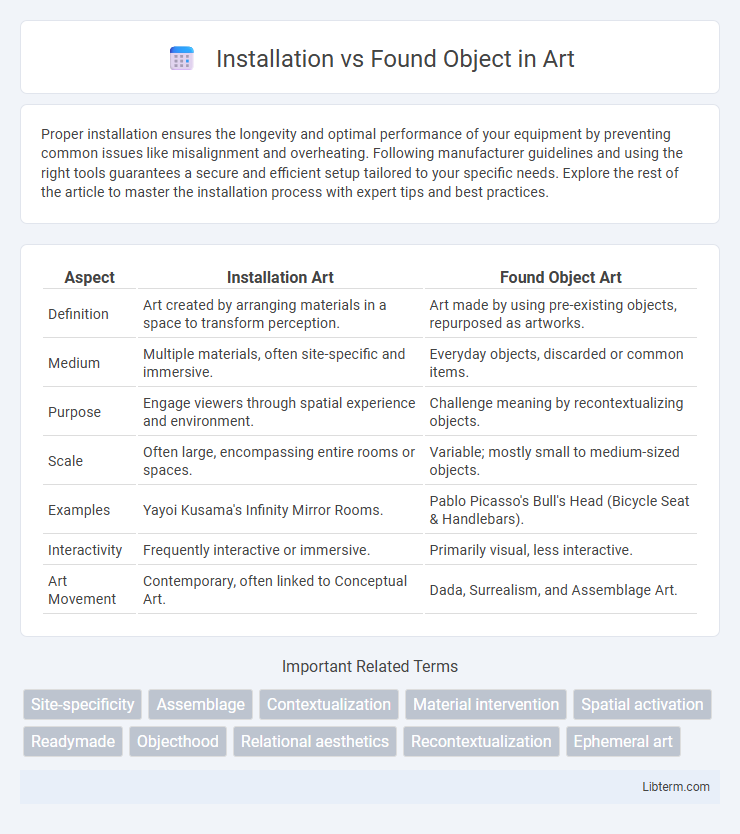Proper installation ensures the longevity and optimal performance of your equipment by preventing common issues like misalignment and overheating. Following manufacturer guidelines and using the right tools guarantees a secure and efficient setup tailored to your specific needs. Explore the rest of the article to master the installation process with expert tips and best practices.
Table of Comparison
| Aspect | Installation Art | Found Object Art |
|---|---|---|
| Definition | Art created by arranging materials in a space to transform perception. | Art made by using pre-existing objects, repurposed as artworks. |
| Medium | Multiple materials, often site-specific and immersive. | Everyday objects, discarded or common items. |
| Purpose | Engage viewers through spatial experience and environment. | Challenge meaning by recontextualizing objects. |
| Scale | Often large, encompassing entire rooms or spaces. | Variable; mostly small to medium-sized objects. |
| Examples | Yayoi Kusama's Infinity Mirror Rooms. | Pablo Picasso's Bull's Head (Bicycle Seat & Handlebars). |
| Interactivity | Frequently interactive or immersive. | Primarily visual, less interactive. |
| Art Movement | Contemporary, often linked to Conceptual Art. | Dada, Surrealism, and Assemblage Art. |
Understanding Installation Art: Definition and Scope
Installation art is a three-dimensional, site-specific work designed to transform the perception of a space through immersive experiences. Unlike found objects, which are single items repurposed as art, installation art integrates multiple elements, including environmental, sensory, and spatial components, to engage viewers in a holistic interaction. This art form often emphasizes context and viewer participation, expanding the boundaries of traditional sculpture and object-based art.
Found Object Art: Origins and Evolution
Found object art, known as "objet trouve," originated in the early 20th century with Marcel Duchamp's transformative readymades, challenging traditional notions of art by repurposing everyday items. This movement evolved through Dada and Surrealism, emphasizing the artistic potential of ordinary objects detached from their original context to provoke new interpretations. Contemporary found object art continues to explore materiality and meaning, often incorporating diverse media to critique consumer culture and redefine aesthetic boundaries.
Key Differences: Installation vs Found Object
Installation art involves creating immersive, site-specific environments that transform a space through a combination of various materials and sensory experiences, emphasizing interaction and spatial relationships. Found object art utilizes pre-existing, often everyday objects repurposed and recontextualized by the artist to convey new meanings or critiques, highlighting the object's original context and artist's reinterpretation. The key difference lies in installation's emphasis on environment and experience versus found object's focus on singular objects and conceptual transformation.
Historical Roots and Influential Movements
Installation art emerged in the early 20th century as artists sought immersive environments, heavily influenced by movements like Dada and Surrealism, which emphasized conceptual disruption and unconventional materials. Found object art traces its roots to Marcel Duchamp's readymades in the 1910s, redefining everyday items as art and challenging traditional aesthetics. Both forms intersect in their challenge to traditional art boundaries, with Installation expanding spatial experience, while Found Object foregrounds recontextualization of ordinary objects.
Materials and Mediums: Site-Specificity vs Readymades
Installation art employs diverse materials tailored to transform and engage a specific environment, promoting site-specificity that interacts directly with the location's spatial and sensory characteristics. Found objects in art emphasize readymades, using everyday, pre-existing materials recontextualized to challenge traditional artistic mediums and authorship. The contrast highlights installation's immersive, spatial manipulation versus found object's emphasis on material appropriation and conceptual reinterpretation.
Artistic Intent: Narrative, Context, and Meaning
Installation art creates an immersive environment designed to convey a specific narrative or conceptual framework, often inviting viewers to interact and engage with the space to understand its context and meaning. Found objects, when integrated into artwork, carry pre-existing cultural or historical significance that artists manipulate to challenge perceptions or highlight new interpretations, enriching the narrative through their inherent associations. The artistic intent in installations centers on shaping a comprehensive sensory experience, whereas found objects rely on their material origin and symbolic resonance to evoke thought and dialogue.
Space and Audience Interaction
Installation art transforms space into an immersive environment where the audience engages physically and emotionally, often encouraging movement and interaction within a defined area. Found object art, by contrast, typically centers on the intrinsic qualities of everyday items recontextualized within a space, prompting viewers to reconsider their relationship with ordinary materials through observation rather than active participation. The spatial dynamics in installation emphasize experiential immersion, while found object pieces invite reflection on context and meaning within their existing surroundings.
Iconic Artists and Landmark Works
Installation art, characterized by immersive, often site-specific environments, contrasts with found object art, which repurposes everyday items to challenge traditional aesthetics. Iconic installation artists include Yayoi Kusama, known for her "Infinity Mirror Rooms," and James Turrell, celebrated for works manipulating light and space, such as "Roden Crater." Marcel Duchamp's "Fountain," a seminal found object piece, redefined art by presenting a readymade urinal as a sculpture, influencing artists like Joseph Cornell and Robert Rauschenberg in exploring ordinary objects as art.
Contemporary Trends in Installation and Found Object Art
Contemporary trends in installation and found object art emphasize immersive environments that challenge traditional gallery spaces by incorporating multimedia elements and interactive components. Artists increasingly use repurposed materials and everyday objects to critique consumer culture and explore themes of sustainability, identity, and memory. This shift reflects a broader movement toward experiential and socially engaged art, blurring the boundaries between art, audience, and environment.
Critical Reception and Cultural Impact
Installation art revolutionized contemporary aesthetics by immersing viewers in spatial experiences, generating critical acclaim for its ability to challenge perceptions and foster interactive engagement. Found object art, rooted in Duchamp's early 20th-century readymades, prompted ongoing debates about authorship and the definition of art, profoundly influencing Dada and Surrealist movements. Both forms have significantly shaped cultural dialogues by questioning artistic conventions and expanding the boundaries of creative expression.
Installation Infographic

 libterm.com
libterm.com